Journey to the Source: An Expedition along the Yangtze River
"When drinking water, think about the source"—or so says the old Chinese proverb. When explorer Wong How Man's parents told him this as a child, though, they couldn't have imagined that it would take him 6,300 kilometres up the Yangtze.
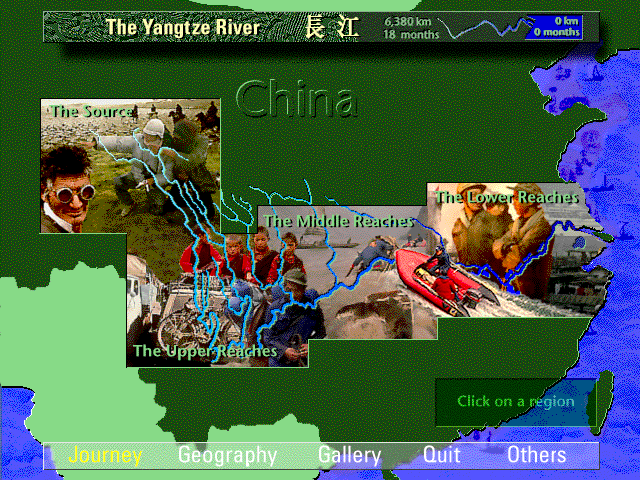
CD-ROMs had been made about anything from classical music to dogs to wine, but a specific river might still seem like a strange subject for a disc. A trip up the river, though, provides rich opportunities: a day-in-the life travelogue, observations of the daily lives of the people they pass by, views of the wildlife and natural sights—and new discoveries, too. Journey to the Source: An Expedition along the Yangtze River is a 1993 non-fiction CD-ROM which follows Wong on one of those voyages.
Journey to the Source documents Wong's 10-month long National Geographic expedition down the Yangtze, conducted between 1985 and 1986, which uncovered a new source for the river. This journey was also documented in his 1989 book Exploring the Yangtze: China’s Longest River (Wong, 1989). Although the river's upper reaches had been explored and mapped for thousands of years, at the time they were still not thoroughly documented by modern standards, and much about the river's origins were still unknown. This was an era when an explorer traveling one of the world's most populated countries could still uncover these kinds of totally unknown geographies. A 1976 survey by PRC geographers had established its source as the Tuotuohe in Qinghai, but Wong and his team had identified a new candidate via a conversation with Yuan Genshen, a member of that team. Beyond simply making the trip to the currently-identified source, they aimed to explore this new lead; their journey took them to the 1976 source and then further afield (China Exploration and Research Society, 2023).
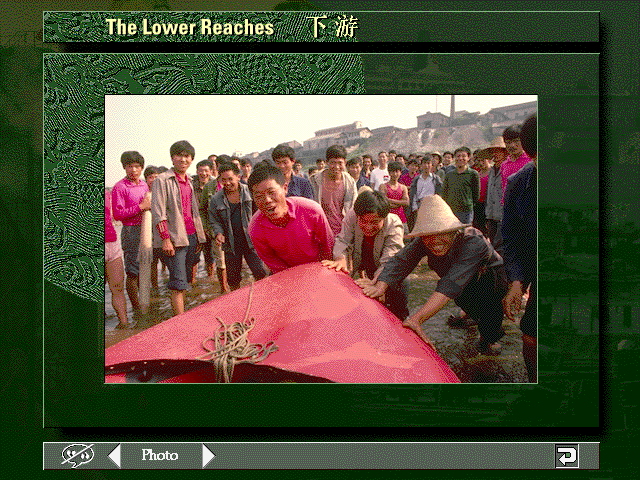
That ten-month journey, taken via a small red motorboat and a Land Cruiser, took its small team from one end of the river to the other. The Yangtze is the third-longest river in the world, running 6,300 kilometres from densely-populated cities by the East China Sea to the distant frontiers of Tibet. Even in the modern day, with the benefit of modern transportation, it's a difficult voyage.
The historical context of the journey's timing provides some extra intrigue on top of their actual goals. 1985 was only a few years after China was opened to foreigners, and not long after the end of the Cultural Revolution; this context is evident throughout the journey. In the lower reaches, Wong and his team periodically encounter western tourists—a new sight, and it's clear that neither tourists nor locals are totally used to each other's presence yet. The effects of the Cultural Revolution too are seen periodically, such as when they set camp near a monastery on the way to Chongqing which is still empty save for its single caretaker.
Wong and his team start in Wuhan, where the Yangtze meets the Han, then slowly make the trip up the river to its other end. The travelogue is indiscriminate in its topics—Wong writes about the weather, the water conditions, the people they meet and the places they see, along with the changes they can see in the process. The result is fascinating.
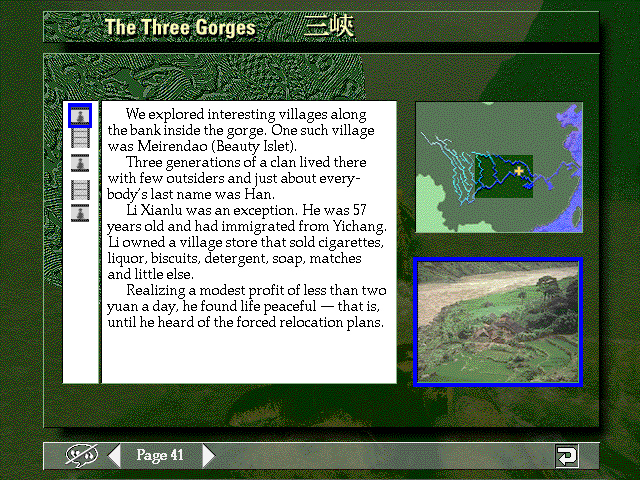
In the lower and middle reaches, the team have quite a few major cities to pass through ranging from Wuhan to Chongqing and Yibin. In these more populated places, while Wong isn't precisely a tour guide, one nonetheless gets the sense of revisiting some fairly well-explored regions. Between those cities, however, they pass through much more rural areas that are clearly both less visited and less documented. By the time they reach the middle reaches, the team is spending most of their time in these rural or unpopulated regions, and these are some of the disc's most fascinating sections. These range from famous sites like the Three Gorges and the hanging coffins of Yibin to far more obscure areas; the several pages devoted to daily life in the village of Meirendao, for example, may well be the only English-language writing on it in existence.
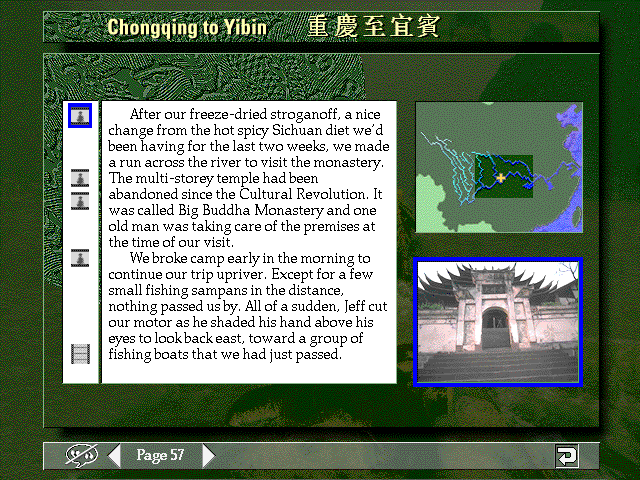
The deeper they make it into the middle reaches, the scarcer population gets; by the time they make it to the upper reaches and beyond, they only occasionally pass through cities and otherwise find themselves in isolated villages or towns. Many of these places, too, had been only rarely visited by western visitors, and so the reader meets them with fresh eyes just as Wong does. One one page, he casually mentions that no westerners have been approved past the point they're crossing; on another, he mentions that only three other foreigners have visited Tiger Leaping Gorge before them and that the last one was over 50 years ago.
By the time they make it to the river's upper reaches, investigating the 1976 source and the tip they'd been given, the only other people around are the nomadic groups in the area. Thanks to their advice and information, Wong's team makes its way further afield to a genuine new source. And there, at the quiet spot on the ground where water bubbles up to form the river, they take a sip in the bracing cold to celebrate their discovery.
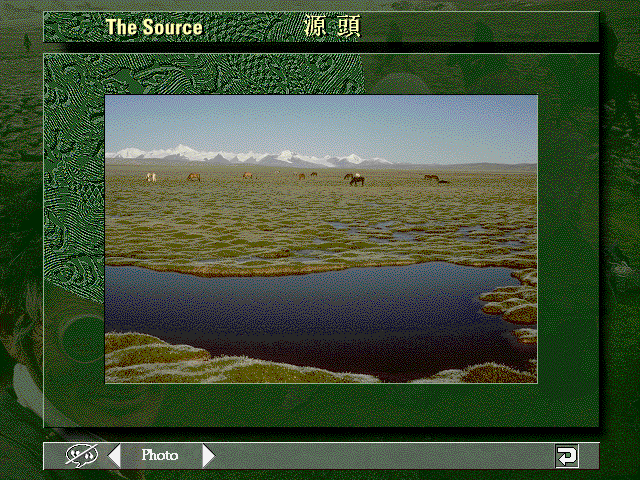
The text is accompanied by Wong's own photography. He took extensive photos over the course of the journey, 400 of which are included on the disc. Each page of text is accompanied by several highly-detailed, fullscreen photos. These are perhaps the most "documentary" part of the disc; they're presented via the beautiful, sweeping vistas and slightly impersonal perspective common to National Geographic, focused on the subject more than the perspective of the photographer. They remain genuinely beautiful and fascinating today; it's easy to spend a large amount of time examining them. While these fullscreen photos have a remarkable sharpness and detail for the period, they also have the characteristic slight softness of vintage film photography. This pairs very nicely with the dithering applied to reduce the colour depth for 1993 monitors; the gentle softness and well-chosen gradient dithering implies film grain at a detail that period monitors wouldn't otherwise have been able to reproduce. It's an attractive look which remains aesthetically interesting today.
The text, photography and video is framed via a well-designed user interface designed by Grid Media's Cynthia Shiu and Fred Mar. The framing manages the difficult task of being at once ornate and non-intrusive, of beautifully framing the material while enhancing its utility. This style of ornate menu design is common to the era, when designers, exploring with the new medium and the relative freedom of 650 megabyte discs and high-resolution 256-colour screens, felt out the edges of what they could accomplish. Journey to the Source employs a restrained but not minimalistic approach, with a regular format from page to page and a focus on legibility for the central text elements. The decorative elements, however, are beautifully designed, evoking classical Chinese art and guiding the eye towards the key interactive elements.
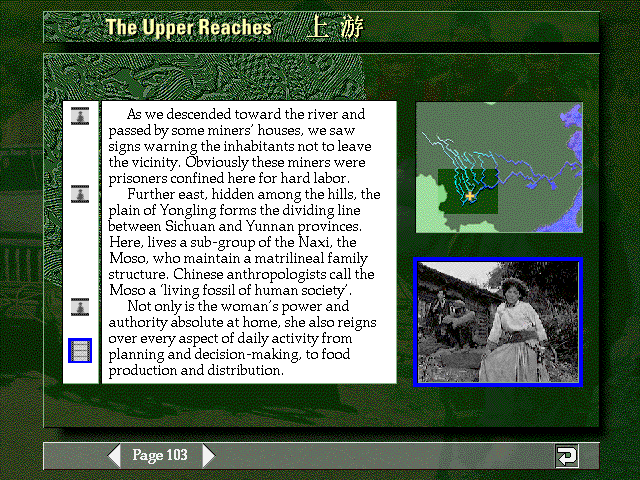
Journey is substantially based on Exploring the Yangtze; much of its text is taken directly from the earlier book, as are many of its photos. It differs in a few key ways: its interactiveness and non-linearity; the inclusion of video; and the narration.
A coffee-table book is maybe the most non-linear sort of book in practice—picked up to rifle through at random at least as often as it's read cover to cover. But the fact remains that the physical format of a book, where pages follow one after another and are ordered in a specific sequence, encourages the reader to browse them in a set order. One of the chances offered by dematerialized formats is the chance to persue them in random order, encouraged or at least enabled by the less linear formats of its user interface. Journey to the Source, though based on a linear book, takes the opportunity to recontextualize itself in the digital medium to encourage new browsing formats. In the default "journey" mode, readers are given a rough chapter map which, right from the start, breaks up the expected English order by running right to left: the four chapters are superimposed over the regions of China in which they take place, which means that a casual reader may in fact browse to the final Source chapter on their very first time reading the disc. Startled, perhaps they'll click back and choose another chapter at random, landing at some other surprise point in the journey. Even within the chapters, the navigation encourages the reader to get playfully lost: rather than simply dropping the reader in at the start of the chapter, they're presented with a zoomed-in map in which they must click a specific city to begin. But here, too, the journey meanders in the physical order followed by our real-life explorers which may not be precisely the order the reader expects, and so a misclick will playfully toss the reader into a surprise location again. Far from frustrating, it turns the journey into a sort of prototypical Geoguesser. The reader can, of course, follow the journey in its chronological order—I did, on my first read. But the format enables a choice.
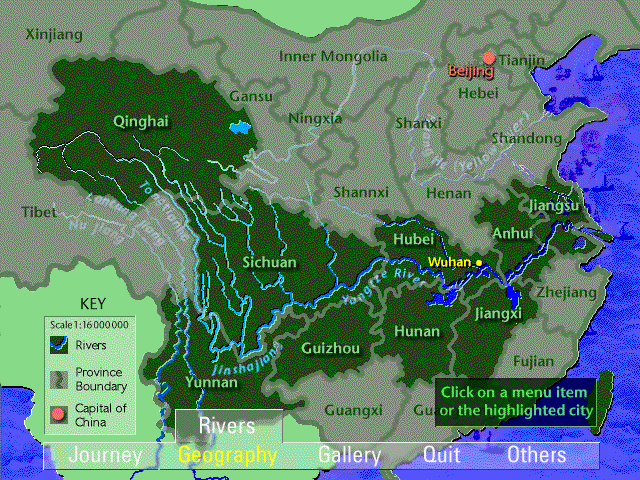
Beyond the "Journey" mode, readers are given another few ways to engage with the material: via a map view, in which they can visualize the provinces and settlements along the 6,000km journey or an alternate map which displays all of the major rivers in the region; and via a gallery view, which allows the reader to browse the disc's 400 photos in a large gallery organized by region and annotated with new captions.
The video, shot via handheld camcorders over the course of the journey, differs sharply from the photography in tone. It has a home video quality and a direct intimacy. Where the photography is carefully framed and documentary in tone the video is casual, conversational. In one video in the streets of Wuhan, the videographer casually chats with the other passengers of the van while moving the camera around to capture everyone's reactions. In another, while watching a group of fishermen at work on the river, the cameraman can be heard talking casually to himself and the other members of the team. Even the technical quality is casual: this is unstabilized handheld video with a sort of "shakycam" quality that communicates genuineness. In a professional documentary, this video would be B-roll, not the main event, shown only briefly and without its original audio. Here, the disc's authors realized just how much that video could communicate when readers have the choice to navigate to it on its own and presented these clips in their original format. If the photography instantly communicates that this is a documentary, National Geographic type of journey, the video brings it back to earth by reminding you that a real group of people went on this ten-month trip and that it's their story being told here. Even the technical qualities tell a story: the team's camera was damaged in the upper reaches, when they were too far to reach anywhere it could be replaced or repaired, and so videos of the latter parts of the journey are in black and white. The quality of the video itself tells a tale of the ardurous nature of the journey.
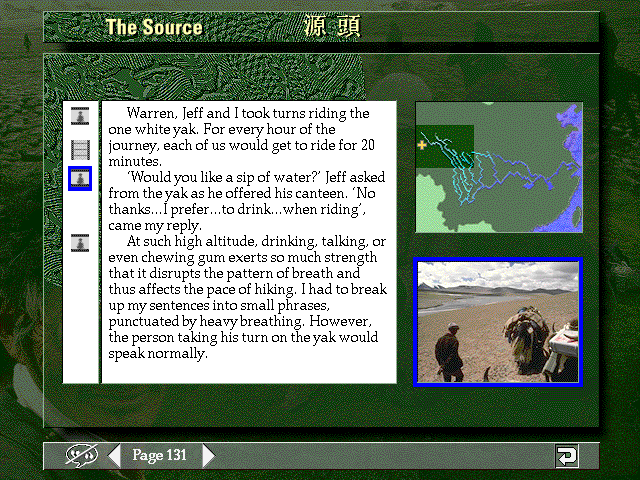
The narration builds on the first-person text by being read out by Wong himself. Given the book's conversational tone, the way it weaves between facts and personal accounts, it's well-suited to being spoken aloud and in particular to be heard in Wong's own voice. Wong is a confident and personable speaker, and hearing it spoken in his own voice further grounds the journey as the specific voyage of a particular set of people.
It's interesting to compare this style to his other books, some of which strike a slightly different tone. For example, the 1990 Islamic Frontiers of China (Wong & Dajani, 2011)[1] is divided into two parts: a first half which describes the long history of Islam in China and which strikes a neutral, encyclopedic tone; and a second half which provides a more free and personal travelogue similar to the one in Journey to the Source. The difference, perhaps, comes from whether a given book aims to describe a region and its history, or a specific voyage through a region. In the case of Islamic Frontiers, the journey was in support of the book's goal of documenting China's Islamic peoples rather than its sole raison d'être.
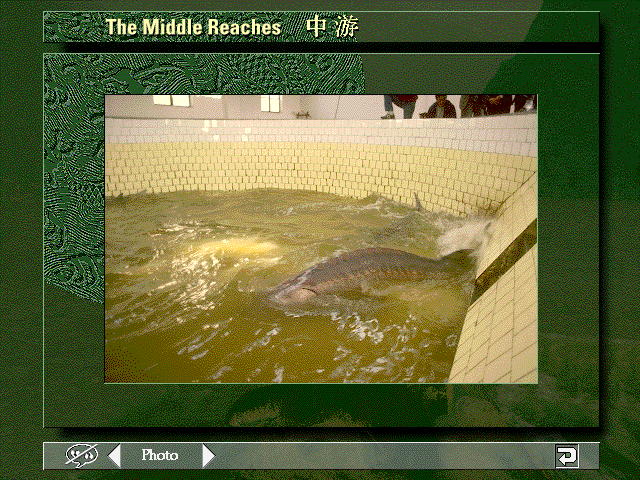
Wong was born in Hong Kong, but studied at University of Wisconsin-River Falls in the United States (UWRF Communication and Media Studies) and lived in the US until 1994 (Kolesnikov, 2007). He worked as an explorer for National Geographic between 1982 and 1986, primarily exploring regions of China; a talented photographer, he acted not only as an explorer but also documented his own trips. He left National Geographic in 1986 to found the Hong Kong organization China Exploration and Research Society (CERS). CERS conducts the same kinds of voyages Wong did at National Geographic, but with a stronger focus on academic research and preservation. As he put it in a 2002 interview with Time Asia, "Everywhere I went I encountered people and customs that I knew were going to vanish almost as soon as I'd photographed them... I realized that to be an explorer in today's world, you can't escape becoming a conservationist." (Jakes, 2002) CERS continues to run expeditions and is active in cultural and natural preservation, and Wong remains its leader.
The disc was developed by Grid Media, a Hong Kong-based new media company founded in 1988 (Dun & Bradstreet). While they had previously focused on work for organizations such as the Hong Kong Science Museum ("China CD-ROM gem wins award", 1993), availability of home computer CD-ROM drives opened the possibility of using rich multimedia software at home. As founder Cynthia Shiu explains in the disc's credits sequence, it was a chance encounter with Wong that provided the inspiration for the disc. Wong had gifted her a copy of Exploring the Yangtze and she realized the potential for a CD-ROM adaptation using his archived slides and tapes.
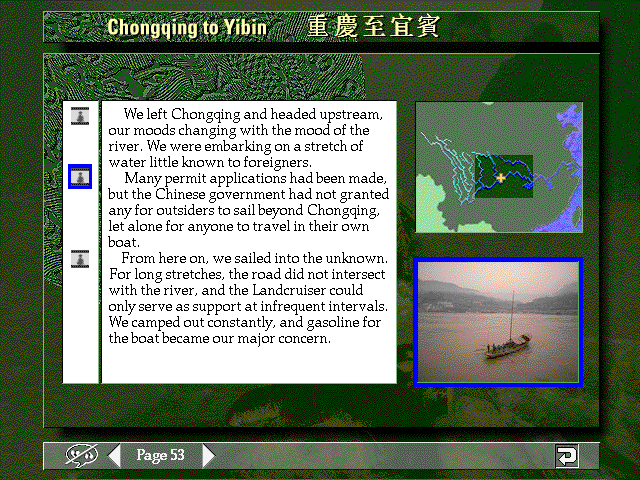
Journey to the Source was well-received across English-speaking Asia. It reviewed well ("Going to bed with with a floppy disk", 1993) and was a winner in the English-language MdN International Design Awards ("China CD-ROM gem wins award", 1993); a Singaporean project cited it as part of the leading edge of Asian-developed CD-ROMs (Christie, 1994). Copies are held by major libraries in Singapore (National Library Board Singapore) and Hong Kong (City University of Hong Kong)[2], attesting to its distribution and local influence. It also reviewed well in Japan ("Jorney[sic] to the Source"), where it received limited distribution in an untranslated edition[3].
Outside Asia, it had less luck. Aside from one copy held at Wong's alma mater (University of Wisconsin-Madison), which may have been a donation from Wong himself, it seems to have received only limited distribution outside Asia. Magazine advertisements and features in Mac (MacMall, 1995) and PC (Ehrenman, 1994) magazines suggest it received some level of distribution in North America and Europe, but this has left none of the usual traces in secondhand sales venues or online sales catalogues. A hint as to the reason for its rarity can be found in a brief note from MacUser writer Nancy Peterson (1996) in a piece on travel multimedia discs. After a positive review, she provides information on its American distributor: an individual, not a company, with just a phone number listed. In the 90s it would have been perfectly possible to get some mail order sales this way via catalogue, but it's unlikely it saw wide distribution. It was, however, cited by Simon Winchester in his 1996 book The River at the Center of the World: A Journey Up the Yangtze, and Back in Chinese Time (1998), which suggests that at least one copy had made its way to Europe, and a "bronze apple" award in the 1995 National Education Media Network Awards in California suggests it may possibly have seen some distribution in schools (Vaughan).
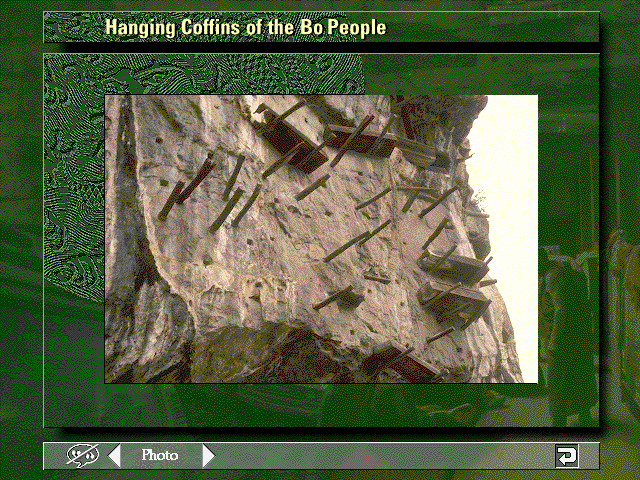
Non-fiction CD-ROMs are an easy butt of jokes about quaint outdated technology; talking about CD-ROM brings up visions of Encarta 95, Microsoft Dogs, and ancient versions of Grolier. When reference discs stand in for any form of non-fiction CD-ROM as a whole, it's easy to dismiss anything else out of hand. These kinds of non-fiction discs were certainly early victims of first the internet, and then Wikipedia. When the goal is to provide an authoritative reference to either a topic or the world at large, free websites aren't a risk just because they're free but also because they update regularly while your CD-ROM stays frozen in the very moment it was pressed. It's only natural that these kinds of reference CD-ROMs died out as the public adopted networked technology.
What makes Journey to the Source interesting by contrast is that it's not an easily obsoletable work. It's not a general guide to the Yangtze; it's a record of a specific voyage. That voyage hasn't been un-done in the future, and later voyages and exploration in the region have done nothing to reduce the value of this specific record. As a personal account of a journey through lands that have dramatically changed in the following decades, in some ways it's only increased in impact. For example, in the Middle Reaches chapter, Wong relates the time spent in the Three Gorges. Already, in 1985, there were talks of building the massive Three Gorges Dam; when it was finally completed, between 2006 and 2012, many of the places Wong had visited were now underwater, the villages flooded and their inhabitants relocated. This narrative, its photos and its videos are valuable records of a time that's now passed.
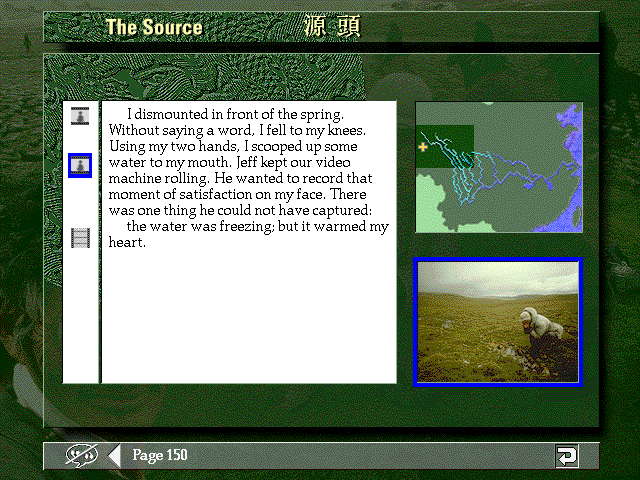
An interesting epilogue to the expedition is Wong's final expedition to the region. In 2004, when reviewing the latest satellite imagery with a friend from NASA, Wong discovered traces of another source of the river that extended several kilometres further back. With this as his guide, he led a second expedition down the river in 2005 which mapped this second source and confirmed it; it still stands as the furthest known source of the river. As he joked in an interview with the South China Morning Post, "How many people get the chance to correct their own mistakes? People usually do their defining work then leave it to future generations to prove them wrong." (Kolesnikov, 2007)
To the extent that that new expedition provides more context on the old one, it doesn't obsolete it. Journey to the Source is still a necessary and engaging journey this many years later, no matter the outcome.
Compatibility note: Journey to the Source is rare and difficult to locate, but for those who are able to track down a copy, the Mac version can be read in emulators such as Basilisk II and SheepShaver. It's also partially compatible with ScummVM.
Notes
1. Consulted in its revised 2011 edition. ↩2. City University of Hong Kong holds the rarer Chinese localized edition, released the year after its original English version ("Going to bed with with a floppy disk"). ↩
3. My personal copy is the Japanese edition, distributed by Mercury Media, which I purchased from Mercari (the Japanese equivalent of Craigslist). It simply packages the original Hong Kong disc and cover with a new Japanese-language back cover. ↩